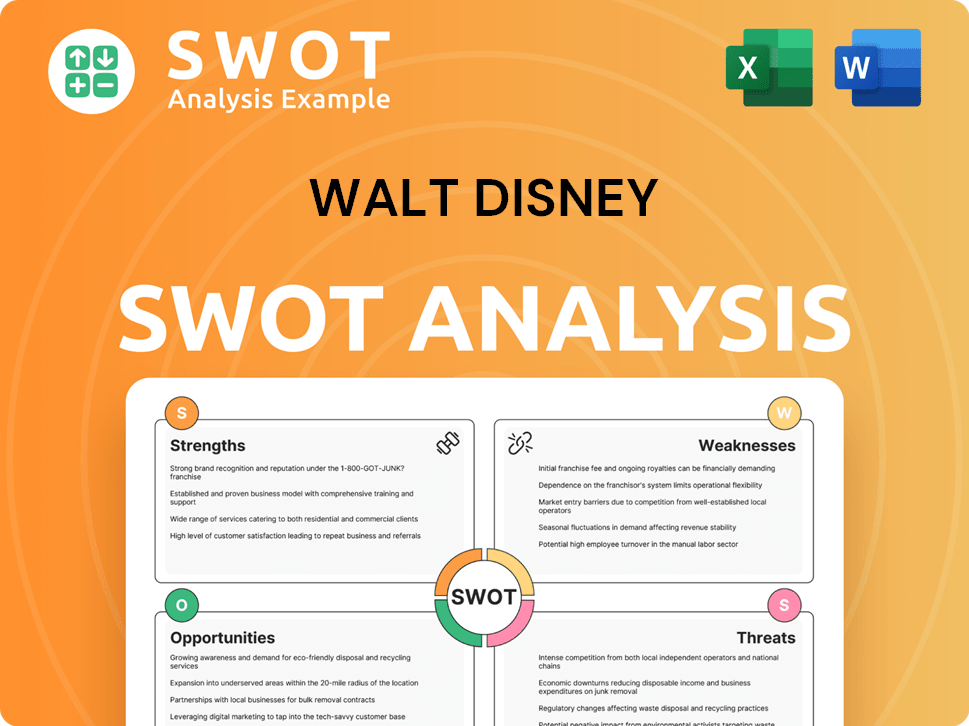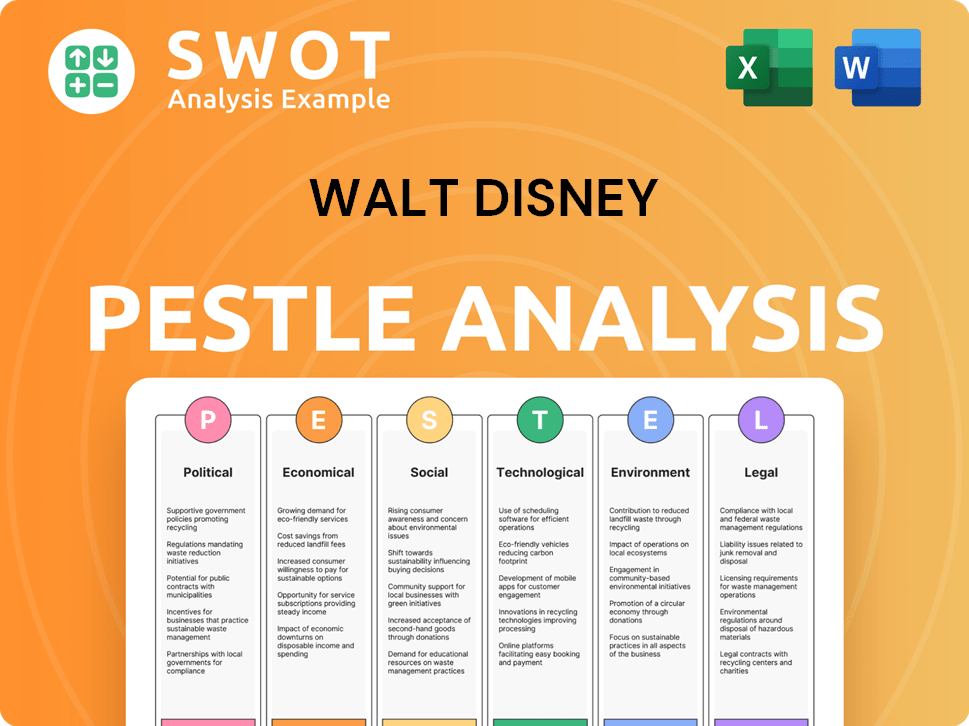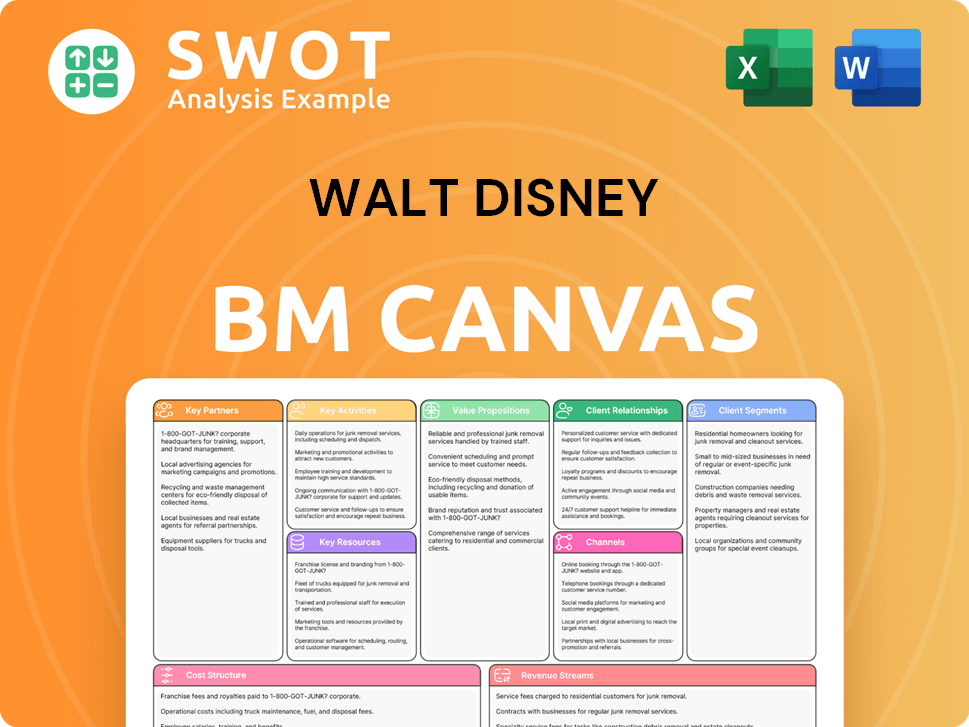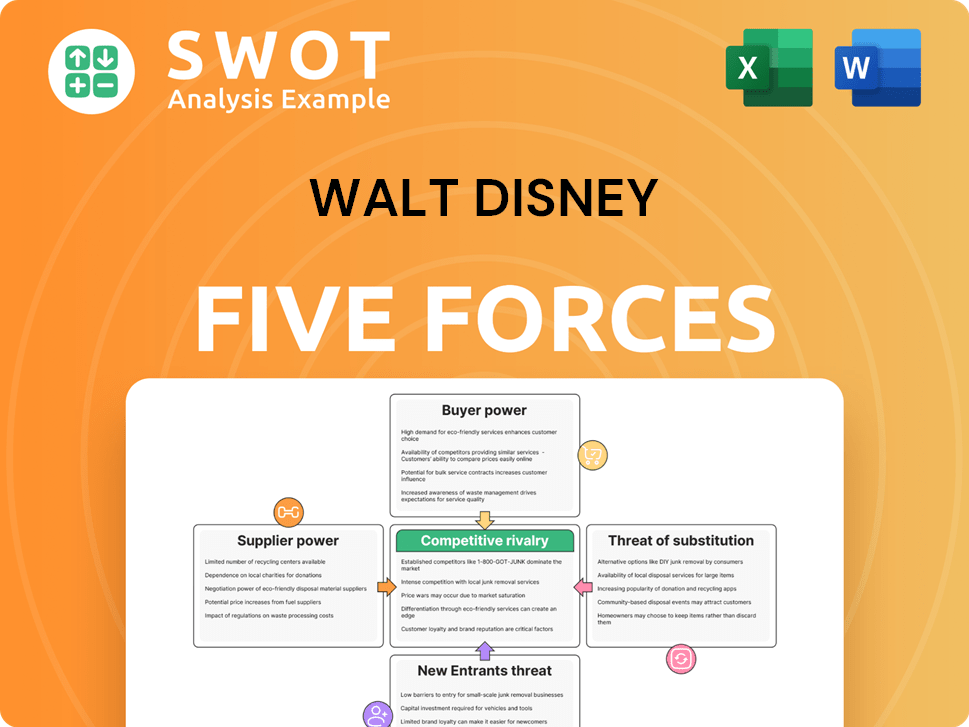Walt Disney Bundle
How Does the Walt Disney Company Dominate the Entertainment World?
The Walt Disney Company, a global entertainment powerhouse, continuously reshapes the media landscape. Its strategic shift towards streaming, highlighted by Disney+, demonstrates remarkable adaptability. This deep dive explores Disney's enduring influence, showcasing its capacity for innovation in a rapidly changing industry. Currently, Disney stands as a leading diversified worldwide entertainment company, known globally for its iconic characters, immersive theme parks, and compelling storytelling.

Understanding the Walt Disney SWOT Analysis is crucial for investors, customers, and industry observers alike. This exploration of Disney's operations, revenue streams, and strategic direction offers valuable insights. We'll examine the Disney business model, its structure, and how its various divisions contribute to its financial performance. Learn how Disney manages its intellectual property and navigates the challenges in today's dynamic entertainment industry, from content distribution to maintaining brand loyalty.
What Are the Key Operations Driving Walt Disney’s Success?
The core operations of the Walt Disney Company revolve around creating and delivering entertainment across multiple platforms. This includes producing content, operating theme parks, selling merchandise, and providing streaming services. The company’s value proposition lies in offering a diverse range of high-quality entertainment experiences that cater to a global audience.
The Disney business model is highly integrated, leveraging synergies across its various segments. For instance, content from its Studio Entertainment division is utilized in its Media Networks and Direct-to-Consumer (DTC) platforms. This integrated approach enables the company to maximize revenue streams and build strong customer loyalty.
The company’s success is underpinned by its ability to create iconic content, operate immersive experiences, and maintain a powerful brand. Its extensive distribution networks and strategic partnerships further enhance its reach and market position. To understand more about who Disney targets, you can read about the Target Market of Walt Disney.
The company operates through several key divisions: Media and Entertainment Distribution, Experiences, and Products. These segments generate revenue from various sources, including television, theatrical releases, theme parks, and consumer products. The Disney structure allows for a diversified approach to revenue generation.
Content creation is central to Disney operations. The Studio Entertainment segment produces films that are distributed theatrically and through various channels. The company also distributes content through its Media Networks, including ABC and ESPN, and its DTC platforms, such as Disney+, Hulu, and ESPN+.
The Parks, Experiences, and Products segment operates theme parks, resorts, and cruise lines globally. These offerings provide immersive entertainment experiences and drive significant revenue. The company continuously invests in expanding and enhancing its theme park offerings.
Technology plays a crucial role in Disney's business strategies, particularly in its streaming services. The company invests heavily in technology to ensure seamless content delivery and personalized user experiences. This includes advancements in content production, distribution, and consumer engagement.
The Disney revenue streams are diversified across its segments. In fiscal year 2023, the Media and Entertainment Distribution segment generated the most revenue, followed by Experiences and Products. The company’s ability to generate revenue from multiple sources contributes to its financial stability.
- In fiscal year 2023, Disney's total revenue was approximately $88.89 billion.
- Media and Entertainment Distribution revenue was around $55.13 billion in fiscal year 2023.
- The Parks, Experiences, and Products segment generated approximately $31.76 billion in revenue in fiscal year 2023.
- Disney+ had approximately 150.2 million subscribers globally as of December 2023.
Walt Disney SWOT Analysis
- Complete SWOT Breakdown
- Fully Customizable
- Editable in Excel & Word
- Professional Formatting
- Investor-Ready Format

How Does Walt Disney Make Money?
The Walt Disney Company (Disney) employs a multifaceted approach to generate revenue, leveraging its diverse portfolio of businesses. This strategy allows Disney to capitalize on various entertainment avenues, ensuring a steady flow of income. Understanding the Disney business model is key to grasping its financial success.
Disney's revenue streams are primarily segmented into Parks, Experiences and Products; Media Networks; Direct-to-Consumer (DTC); and Studio Entertainment. Each segment contributes significantly to the company's overall financial performance, reflecting its broad market presence. The Disney operations are designed to maximize revenue across these diverse areas.
In Q1 2024, Disney reported total revenues of $23.5 billion, illustrating its substantial financial scale. The company's ability to adapt and innovate within these segments is crucial to its ongoing success and market leadership.
Disney's revenue streams are diverse, with each segment contributing significantly to overall financial performance. These segments include Parks, Experiences and Products; Media Networks; Direct-to-Consumer (DTC); and Studio Entertainment. This diversified approach helps mitigate risks and ensures a steady income stream.
- Parks, Experiences and Products: Generated $8.39 billion in Q1 2024. This segment includes theme park admissions, resort stays, cruise line operations, and merchandise sales. Revenue decreased from $8.74 billion in the prior-year quarter.
- Media Networks: This segment, including channels like ABC and ESPN, brought in $6.7 billion in Q1 2024. Revenue comes from advertising, affiliate fees, and content licensing.
- Direct-to-Consumer (DTC): This segment, encompassing Disney+, Hulu, and ESPN+, is a strategic growth area. While reporting an operating loss of $138 million in Q1 2024, this was an improvement from a $984 million loss in the prior year, indicating progress toward profitability. Revenue is primarily driven by subscriptions.
- Studio Entertainment: Responsible for film production and distribution, this segment generated $2.48 billion in Q1 2024. Revenue comes from theatrical releases, home entertainment, and content licensing.
Disney employs several innovative monetization strategies to maximize its revenue. These strategies include bundled streaming offerings and leveraging its intellectual property across various segments. These approaches help Disney maintain its competitive edge and generate strong financial results. Understanding these strategies is key to analyzing the Growth Strategy of Walt Disney.
- Bundled Streaming: Offers tiered pricing and encourages cross-subscription. The 'Disney Bundle' is a prime example, providing access to multiple platforms at a discounted rate.
- Intellectual Property Leverage: Disney uses its vast content library and brand equity across all segments. This includes character merchandise in parks, retail stores, and licensing agreements for video games.
Walt Disney PESTLE Analysis
- Covers All 6 PESTLE Categories
- No Research Needed – Save Hours of Work
- Built by Experts, Trusted by Consultants
- Instant Download, Ready to Use
- 100% Editable, Fully Customizable

Which Strategic Decisions Have Shaped Walt Disney’s Business Model?
The Walt Disney Company has a rich history marked by significant milestones and strategic shifts. A pivotal moment was the launch of Disney+ in November 2019, a move that transformed the company's focus towards direct-to-consumer streaming. This strategic pivot allowed Disney to compete directly with other major streaming services, leveraging its vast content library to gain a strong foothold in the market. The company's ability to adapt and innovate has been crucial to its enduring success.
Operational challenges have included navigating the impact of the COVID-19 pandemic, which significantly affected its Parks, Experiences, and Products segment due to closures and reduced capacity. Disney responded by implementing stringent health and safety protocols and adapting its operational models to maintain business continuity. More recently, the company has been focused on achieving profitability in its streaming segment, which has involved content rationalization and price adjustments. These moves reflect Disney's commitment to long-term financial health and strategic growth.
The Disney business model is built on a foundation of strong competitive advantages. Its unparalleled brand strength and global recognition foster immense customer loyalty. The extensive intellectual property, including iconic characters and franchises, provides a consistent source of content for all its segments. Economies of scale in content production and distribution allow for efficient resource allocation and broader market reach. The synergistic ecosystem, where content from its studios fuels its streaming services and theme parks, creates a powerful virtuous cycle that reinforces its market position. Disney continues to adapt to new trends by investing in new technologies, such as virtual and augmented reality for its parks and streaming experiences, and by exploring new content genres and formats to appeal to diverse audiences.
The launch of Disney+ in November 2019 was a major strategic move. The acquisition of Pixar in 2006 and Marvel Entertainment in 2009 also significantly expanded its content library. These acquisitions have fueled the company's growth in both the film and theme park sectors.
Expanding into streaming services with Disney+ was a key strategic decision. Focusing on international expansion, particularly in Asia, has been another important move. These strategies aim to diversify revenue streams and increase global market share.
Strong brand recognition and customer loyalty are crucial competitive advantages for the Walt Disney Company. Its vast intellectual property portfolio provides a consistent stream of content. The ability to create a synergistic ecosystem across its various segments is also a key strength.
The company operates through distinct Disney divisions, including Media and Entertainment Distribution, Parks, Experiences and Products, and Studios. This structure allows for focused management and efficient resource allocation. The company's diverse operations contribute to its overall financial performance.
In fiscal year 2023, Disney's revenue reached approximately $88.9 billion. The Parks, Experiences and Products segment generated $31.8 billion in revenue. The Media and Entertainment Distribution segment accounted for $56.7 billion. Disney's market capitalization is around $200 billion as of late 2024, reflecting its strong market position and investor confidence. For more detailed information, you can read this article about the Walt Disney Company.
- Disney's streaming services, including Disney+, Hulu, and ESPN+, have a significant subscriber base.
- The company's ability to monetize its content across various platforms is a key driver of its revenue.
- The company's strategic focus on direct-to-consumer streaming has been a major factor in its revenue growth.
- Disney's diversified business model helps to mitigate risks and create multiple revenue streams.
Walt Disney Business Model Canvas
- Complete 9-Block Business Model Canvas
- Effortlessly Communicate Your Business Strategy
- Investor-Ready BMC Format
- 100% Editable and Customizable
- Clear and Structured Layout

How Is Walt Disney Positioning Itself for Continued Success?
The Walt Disney Company holds a prominent position in the global entertainment industry, with significant market share across various segments, including theme parks, film production, and streaming services. Its strong brand loyalty is a key differentiator, with generations of consumers having a deep emotional connection to its characters and stories. Disney's global reach is extensive, with theme parks and media distribution channels spanning continents.
However, the company faces several key risks. Regulatory changes, particularly concerning antitrust and media consolidation, could impact future acquisitions or collaborations. New competitors in the streaming space and evolving consumer preferences for content consumption pose ongoing challenges. Technological disruption, such as advancements in AI-driven content creation or new distribution models, could necessitate further adaptation. Geopolitical tensions and economic downturns can also affect consumer spending on entertainment and travel, impacting park attendance and advertising revenues.
The Walt Disney Company is a global leader in entertainment, with a diverse portfolio including media networks, parks, experiences, and products. It has a substantial market capitalization, reflecting its strong financial performance and brand value. The company's ability to generate revenue from various sources, including box office sales, theme park admissions, and merchandise, contributes to its dominant industry position.
The company faces risks from evolving consumer behavior, technological advancements, and economic conditions. Competition in the streaming market and changing viewing habits pose challenges. Regulatory scrutiny and geopolitical factors can also impact Disney's operations. Furthermore, economic downturns could affect consumer spending on entertainment and travel.
Disney's future outlook is shaped by strategic initiatives focused on sustained profitability in its direct-to-consumer segment, optimizing its content slate, and exploring new revenue opportunities. Innovation in immersive technologies for theme parks and new content formats for streaming platforms are key. The company aims to leverage its iconic brands and storytelling prowess to deliver entertainment experiences across all platforms.
Core strategies involve content creation, brand expansion, and technological innovation. Disney focuses on producing high-quality content for its streaming services and theatrical releases. Expanding its theme parks and experiences globally is also a priority. Technological advancements, such as AI and immersive experiences, are being integrated to enhance consumer engagement.
In fiscal year 2023, Disney reported total revenue of approximately $88.9 billion, with significant contributions from its Parks, Experiences, and Products segment, as well as its Media and Entertainment Distribution segment. The company's direct-to-consumer streaming services, including Disney+, are a key focus area, with ongoing efforts to increase subscribers and achieve profitability. Disney is also investing in new content and expanding its theme park offerings to drive growth.
- Continued expansion of streaming services, focusing on subscriber growth and content offerings.
- Investment in new theme park attractions and experiences to enhance visitor engagement.
- Strategic partnerships and acquisitions to strengthen its content library and market position.
- Focus on cost efficiency and operational improvements to enhance profitability.
Walt Disney Porter's Five Forces Analysis
- Covers All 5 Competitive Forces in Detail
- Structured for Consultants, Students, and Founders
- 100% Editable in Microsoft Word & Excel
- Instant Digital Download – Use Immediately
- Compatible with Mac & PC – Fully Unlocked

Related Blogs
- What are Mission Vision & Core Values of Walt Disney Company?
- What is Competitive Landscape of Walt Disney Company?
- What is Growth Strategy and Future Prospects of Walt Disney Company?
- What is Sales and Marketing Strategy of Walt Disney Company?
- What is Brief History of Walt Disney Company?
- Who Owns Walt Disney Company?
- What is Customer Demographics and Target Market of Walt Disney Company?
Disclaimer
All information, articles, and product details provided on this website are for general informational and educational purposes only. We do not claim any ownership over, nor do we intend to infringe upon, any trademarks, copyrights, logos, brand names, or other intellectual property mentioned or depicted on this site. Such intellectual property remains the property of its respective owners, and any references here are made solely for identification or informational purposes, without implying any affiliation, endorsement, or partnership.
We make no representations or warranties, express or implied, regarding the accuracy, completeness, or suitability of any content or products presented. Nothing on this website should be construed as legal, tax, investment, financial, medical, or other professional advice. In addition, no part of this site—including articles or product references—constitutes a solicitation, recommendation, endorsement, advertisement, or offer to buy or sell any securities, franchises, or other financial instruments, particularly in jurisdictions where such activity would be unlawful.
All content is of a general nature and may not address the specific circumstances of any individual or entity. It is not a substitute for professional advice or services. Any actions you take based on the information provided here are strictly at your own risk. You accept full responsibility for any decisions or outcomes arising from your use of this website and agree to release us from any liability in connection with your use of, or reliance upon, the content or products found herein.